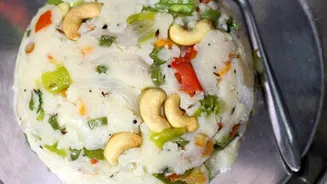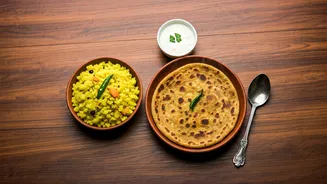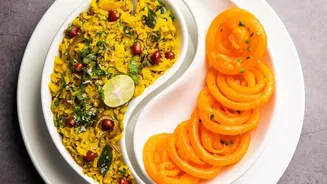South Indian Staples
South India offers some fantastic winter breakfast options. Start with idli and sambar, a steamed rice cake often paired with a lentil-based vegetable
stew. This is a light and easily digestible option. Dosa, a thin crepe made from fermented batter, is another favorite, served with various fillings and chutneys. The slight tang from the fermentation process is satisfying. Upma, a savory porridge made from semolina or wheat, is enriched with vegetables and spices, offering warmth and flavor. Then there is Pongal, a hearty rice and lentil dish seasoned with spices and often served with coconut chutney and sambar. These breakfast dishes give you the needed carbohydrates and essential nutrients to face the day.
North Indian Delights
Moving north, there are equally enticing breakfast choices. Aloo paratha, a flatbread stuffed with spiced potatoes, is a quintessential winter breakfast, providing a filling and comforting meal. It is often served with yogurt and pickles. Similarly, gobi paratha, with a cauliflower filling, offers a delicious alternative. Another warm choice is the humble Poha, a flattened rice dish tempered with mustard seeds and curry leaves, often garnished with onions and coriander. It is a light yet fulfilling dish, often enjoyed with a squeeze of lemon. You cannot exclude the iconic Chole Bhature, a deep-fried bread served with a spicy chickpea curry – a hearty and delicious indulgence perfect for colder days.
West and East's Flavors
Venture west and east for more breakfast ideas. In the western regions, consider Misal Pav, a spicy lentil curry served with bread rolls, offering a flavorful and satisfying start to the day. It provides a kick of spice to warm you from the inside out. Then there is the Puran Poli, a sweet flatbread with a lentil and jaggery filling, a dessert-like breakfast treat. Heading east, Luchi and Aloo Dum is a popular combination – puffy, deep-fried bread with a spicy potato curry, often enjoyed during festive occasions and winter mornings. Other choices include the delicious and healthy Ghugni, a spicy snack made from dried yellow peas, often eaten as breakfast.
Unique Regional Specials
Beyond the mainstream, India features diverse regional breakfast options. In states like Bihar, the delicious and filling Litti Chokha offers a unique taste, featuring baked wheat balls served with a mashed vegetable side. It’s hearty and flavorful. From Gujarat comes Thepla, a spiced flatbread often eaten with curd or pickles, known for its soft texture. Maharashtra offers Thalipeeth, a multi-grain pancake packed with flavors and textures. The dish is a wholesome, savory breakfast choice. These unique breakfast options reflect regional influences and provide a taste of Indian culinary diversity. They are not only delicious but also offer a glimpse into the diverse food cultures across the country.
Sweet and Savory Fusion
India's breakfast scene is not limited to distinct sweet or savory options; it’s a fusion of both. Consider the traditional Gulab Jamun, a sweet, deep-fried dessert which is eaten along with many savory breakfast options. Also, there's Shrikhand, a thick, creamy yogurt dessert flavored with saffron and cardamom. It is a cooling contrast to the hot dishes on offer. Many breakfasts offer a combination of textures and flavors. For example, a South Indian meal can include a sweet Kesari bath (a semolina-based sweet dish) alongside savory dosa or idli. This blend caters to various palates, making Indian breakfast a diverse experience. Each dish has its own unique mix of ingredients and spices.
Spice and Comfort
The key characteristic of Indian winter breakfasts is the use of spices to provide warmth. Dishes use spices such as ginger, cardamom, cinnamon, and black pepper. They are incorporated into various dishes. These spices not only enhance the flavor but also help warm the body. Turmeric is another key ingredient, known for its anti-inflammatory properties. The variety of spices provide different health benefits. Masala chai, a spiced tea, is a common beverage pairing with breakfast, providing a warm and comforting sensation. The judicious use of these spices makes Indian breakfasts perfect for colder weather. It provides a unique balance of flavors.
Healthy Breakfast Choices
Health is at the heart of the selection of Indian breakfasts. Many options are nutritious. Dishes such as Upma, Pongal, and Poha feature grains, lentils, and vegetables, providing a balance of carbohydrates, proteins, and vitamins. The inclusion of millets in dishes offers added nutritional value, making breakfast more wholesome. Yogurt and curd are common side dishes. They promote gut health and digestion. Many preparations are steamed, reducing oil content. This approach supports a balanced diet. Prioritizing fresh ingredients and lighter cooking methods makes Indian winter breakfasts healthy and satisfying. This contributes to overall well-being.
Breakfast across India
Breakfast traditions vary significantly across India. The ingredients and methods often reflect regional produce and culinary traditions. This regional diversity creates a broad variety of breakfast options. The type of grains used, the spices, and the preparation methods vary. For example, in the north, wheat-based parathas are common, while in the south, rice-based preparations dominate. In some regions, breakfast might include both savory and sweet dishes. The evolution of dishes over time shows cultural influences. These influences are from migration and trade. This leads to unique combinations of ingredients and preparation styles.
Seasonal Considerations
Winter season plays a crucial role in deciding breakfast choices across India. The emphasis is on warm, filling, and nourishing meals during colder months. Ingredients that provide warmth, such as root vegetables and certain spices, get more prominence. Dishes that offer high energy are also preferred. This includes options such as parathas, which provide sustained energy. Fresh seasonal produce, like green leafy vegetables and root vegetables, play a key role. Eating seasonal foods adds nutrients and helps adapt to changing weather conditions. This seasonal approach is the core of traditional Indian cuisine. It supports optimal health and wellness through the winter months.
Tips and Tricks
Planning and preparation help in creating delicious Indian winter breakfasts. Preparing ingredients ahead of time saves time and effort. Pre-chopping vegetables and mixing spices streamlines the cooking process. Cooking in bulk and storing dishes in the refrigerator enables quick meals. Experimenting with different recipes and regional variations keeps breakfast fun and exciting. Adding fresh herbs and garnishes enhances both flavor and visual appeal. Balancing flavors and textures makes the meal satisfying. It is recommended to use seasonal ingredients. Make breakfast a personal experience.













